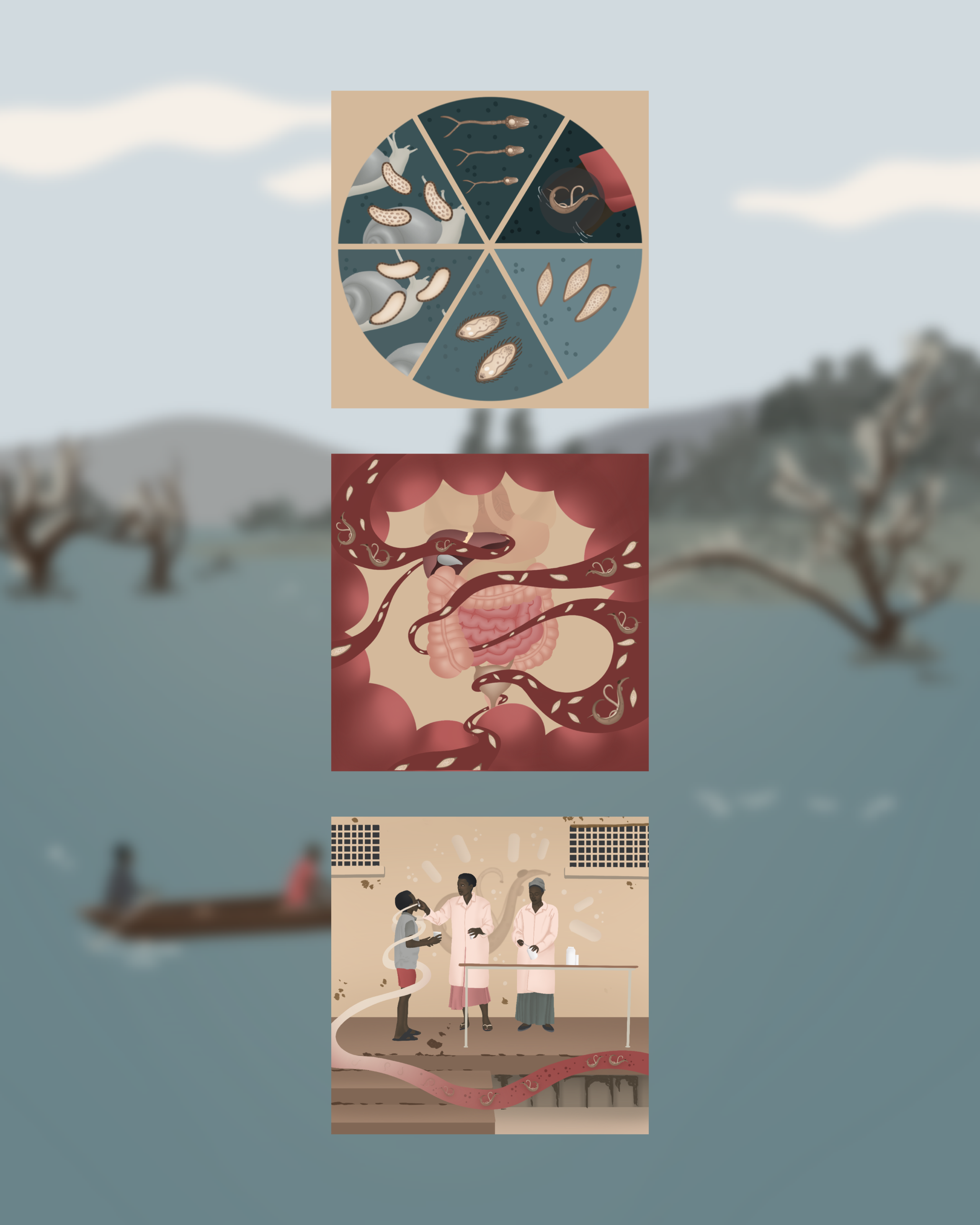
About Schistosomiasis
Schistosomiasis is the leading cause of mortality of all the neglected tropical diseases, with an estimated 779M people at risk of infection.
Overview
caused by infection with parasitic worms that spread through contact with fresh water contaminated with human waste. It is the leading cause of mortality of all the neglected tropical diseases.
Schistosomiasis, or snail fever, is caused by contact with parasitic worms spread through snails that live in fresh water contaminated with human waste. Snail fever has severe negative effects on health and wellbeing, damaging the liver, kidney, and bladder, leading to serious illness and possible death.
Schistosomiasis is the second most devastating parasitic disease after malaria in terms of public health impact, leading to symptoms such as:
- malnutrition
- anemia
- impaired cognitive & physical development
- chronic fatigue
- stunted growth
- weak immune system
All of which can leave children especially vulnerable to other illnesses. Women in particular are at risk of contracting female genital schistosomiasis, a painful condition that increases the risk of infertility and their vulnerability to sexually transmitted infections.
Snail fever’s effects on cognitive and physical development can make it difficult for infected children to learn and thrive, potentially keeping them away from school and causing long-term educational deficits and economic consequences.
The disease also impacts people’s livelihoods – people who work near the water, such as fishermen and agricultural workers, are at high risk of infection.
But there is a cure for schistosomiasis in praziquantel, and The END Fund is dedicated to partnering with local governments and health workers to support and administer mass treatment campaigns of praziquantel and other medicine to treat entire communities at risk.
Providing schistosomiasis treatment to adults as well as children improves their ability to earn a living, which can have profound economic benefits. An estimate of the effects of treating schistosomiasis in Ethiopia, Kenya, Rwanda, and Zimbabwe found that $2,7 billion in GDP gains could be realized.
This approach not only helps cure individuals but also dramatically reduces the spread of the parasite in the environment and communities around the water sources where schistosomes thrive—protecting whole populations, preventing reinfection, and moving us closer to eliminating snail fever altogether.
causes severe effects on health and wellbeing. The infection hinders children’s physical and mental growth, making it difficult for them to learn and thrive. It causes damage to the organs including the liver, kidney, and bladder, which can lead to serious illness or even death. The disease impacts people’s livelihoods – people who work near the water such as fishermen and agricultural workers are at high risk of infection. Women are at risk of female genital schistosomiasis, a painful condition that increases their vulnerability to sexually transmitted infections and infertility.
Treating entire communities at risk of schistosomiasis is key to elimination. Providing praziquantel to adults as well as children improves their ability to earn a living, which can have profound economic benefits. An estimate of the effects of treating schistosomiasis in Ethiopia, Kenya, Rwanda, and Zimbabwe found that $2.7 billion in GDP gains could be realized.

Key Facts
251 million
people require treatment for schistosomiasis1
78 countries
are endemic2
90%
of people requiring treatment live in Africa3
52 million
women estimated to have female genital schistosomiasis
Rwanda has provided over 85 million treatments to communities at risk, bringing the country closer to making the disease history
Before the creation of Rwanda’s neglected tropical disease program in 2007, there had been little research on schistosomiasis. But in 2019, the Rwandan government began financing 100 percent of the operational costs related to mass treatment campaigns that have successfully curtailed these parasitic infections.
In 2007 to 2008, the country’s prevalence mapping results showed that there was a heavy burden of schistosomiasis in many areas of the country at 69.5 percent across the surveyed schools.

After years of treatment through mass treatment campaigns, the government re-surveyed schistosomiasis in 2014. The results, however, showed that the disease was more widespread throughout the country than previously believed with cases present in almost every district in areas surrounding perennial water bodies.
The progress was due to improved sampling methodology, and for schistosomiasis, a more sensitive rapid test called (CCA test).
Rwanda provides treatment for snail fever at the community level to school age children and adults living or working in areas that are at a high risk of the disease, ensuring that resources are effectively used across the entire community. This differs from past campaigns that used to target just school age children, the group considered to be at the highest risk of long-term damage because of these parasites. This holistic approach ensures that the cycle of transmission can be stopped for good.
Schistosomiasis has reached a threshold of elimination as a public health problem, meaning prevalence has been reduced to below 1 percent of heavy intensity infections in 97 percent of surveyed villages according to remapping in 2020. This outcome follows years of effective treatment campaigns that were the result of Rwanda’s steadfast commitment to elimination.

THE END FUND’S ROLE in stopping parasitic infections
The END Fund supports schistosomiasis elimination efforts through our Deworming Innovation Fund and Flagship Fund. The Deworming Innovation Fund aims to accelerate progress towards eliminating schistosomiasis and soil-transmitted helminths in Ethiopia, Rwanda, Zimbabwe and Kenya. This effort will improve the health, quality of life, educational and economic prospects of more than 40 million people living in these four countries.
The fund continues to support and amplify commitments made by local leaders to ensure that nobody in need of deworming treatment is left behind and that programs reach at-risk population groups often overlooked in treatment campaigns, including women of reproductive age and children who are not yet in school.
Other neglected tropical diseases





